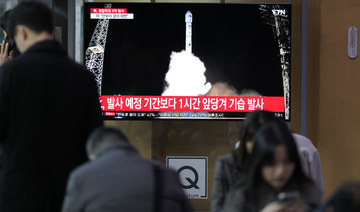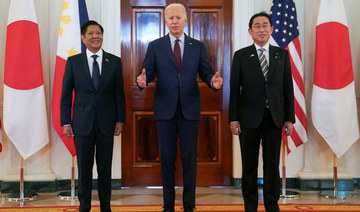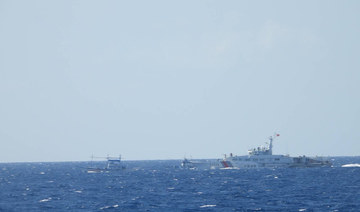Egypt has agreed to reopen airspace with Qatar
For deaf children in Pakistan, school is life

- Of more than a million deaf school-age children in Pakistan, less than five percent go to school
- According to World Federation of the Deaf, 80 percent of world’s 70 million deaf people have no access to education
LAHORE: At a school for the deaf in Pakistan, the faces of students are animated, their smiles mischievous, as their hands twirl in tandem with their sign language teacher.
The quiet classes exude joy, led often by teachers who are also deaf.
“I have friends, I communicate with them, joke with them, we share our stories with each other about what we have done and not done, we support each other,” said Qurat-ul-Ain, an 18-year-old deaf woman who joined the school a year ago.
More than 200 pupils, children and adults mostly from disadvantaged backgrounds, are among the few given a new fervor for life at this inner-city school in historic Lahore.
Of more than a million deaf school-age children in Pakistan, less than five percent go to school.
The figure is even lower for girls and, without a language to express themselves, many children are marginalized by society and even their families.
“Life is a little difficult. There is a huge communication gap here where people generally don’t know sign language,” said Qurat-ul-Ain.
At the school run by charity Deaf Reach, pupils learn sign language in English and Urdu before progressing on to the national curriculum.
Everyone has a name in sign language, which often has to do with a physical characteristic.
Younger children learn with visuals: a word and a sign are associated with an image.
Their peers turn their thumbs down for a wrong answer and make the applause sign — twisting hands — for a correct one.
Founded in 1998 by an American and funded with donations, Deaf Reach now has eight schools across the country, educating 2,000 students on a “pay what you can afford” basis, with 98 percent of children on scholarships.
The vast majority of students at the school come from hearing families, who are also offered the chance to learn how to sign and break the language barrier with their son or daughter.
Adeela Ejaz explained how she struggled to come to terms with her first born son — now 10 years old — being deaf.
“When I couldn’t understand what he was trying to say he would bang his head against the wall and floor,” the 35-year-old told AFP.
“It was tough for everyone because no-one knew how to communicate with him. Everyone would tell us he is deaf but I wasn’t prepared to accept that.”
The mother and son pair are now both learning to sign.
“I am getting better at signing and I am able to communicate with my son. He’s now become so attached to me.”
“ATTITUDES IMPROVING”
The program makes extensive use of technology, and offers an online dictionary and a phone app.
It has also found employment for more than 2,000 deaf people with around 50 Pakistani companies.
Huzaifa, 26, who became deaf after contracting a fever at a young age, was given a stitching apprenticeship at Deaf Reach to help him into the skilled workforce.
“Teachers in the government school didn’t know any sign language. They would just write notes on the board and tell us to copy it. We used to get really disheartened, and I would be extremely worried for my future,” he told AFP.
His family pushed for him to become educated, helping him to learn the basics of sign language before he received formal coaching.
“My parents never threw me away. They spared no effort in ensuring I was able to continue my education,” he said.
Without their dedication, he said: “I’d be working as a day laborer somewhere, cutting leaves or cementing walls.”
Sign language varies from one country to another, with its own associated culture, and regional variations sometimes exist.
According to World Federation of the Deaf, 80 percent of the approximately 70 million deaf people in the world have no access to education.
“I used to sit idly at home, use the mobile or play outside. I never had a clue about what people were saying,” said Faizan, 21, who has been at Deaf Reach for 11 years and dreams of working abroad.
“Before learning how to sign I used to feel very weak mentally and had an inferiority complex and fear. But thankfully there is none of that anymore.”
Attitudes toward people with disabilities are slowly improving in Pakistan, which has introduced laws against discrimination.
“We have seen over the years the mentality change tremendously. From many people hiding their deaf children, feeling embarrassed, ashamed,” noted Daniel Marc Lanthier, director of operations of the foundation behind Deaf Reach.
Nowadays families are “coming out in the open, asking for education for their children, asking to find employment for them,” he said, though much work remains.
“With a million deaf children who don’t have access to school, it’s a huge challenge, it’s a huge goal to be met.”
‘Unlikely’ to be more survivors from Papua New Guinea landslide

- Some 2,000 people are feared buried by a massive landslide that entombed a remote highland community
- Full-scale rescue and relief efforts have been severely hampered by the remote location
PORT MORESBY: It is “very unlikely” more survivors of Papua New Guinea’s deadly landslide will be found, a UN agency warned Tuesday, as thousands at risk from further slips were ordered to evacuate.
Some 2,000 people are feared buried by a massive landslide that entombed a remote highland community in the early hours of May 24.
Since then, locals have been picking through a hellscape of meters-deep churned-up earth, uprooted trees and car-sized boulders in the search for loved ones — often using little more than their hands, shovels and digging sticks.
But hopes are dimming that anyone is alive underneath the mountain of rubble.
“It is not a rescue mission, it is a recovery mission,” UNICEF Papua New Guinea’s Niels Kraaier said. “It is very unlikely they will have survived.”
Full-scale rescue and relief efforts have been severely hampered by the remote location, the only road link being severed, heavy rainfall and nearby tribal violence.
The Papua New Guinea Defense Forces have struggled to access the site with heavy earth-moving equipment.
Early on Tuesday, Enga provincial administrator Sandis Tsaka warned the disaster could worsen further, as clumps of limestone, dirt and rock continue to shear off the side of Mount Mungalo.
Tsaka said authorities were now trying to coordinate the evacuation of almost 7,900 more people.
“The tragedy is still active,” he said. “Every hour you can hear rock breaking — it is like a bomb or gunshot and the rocks keep falling down.”
Aid officials said many residents were refusing to leave at-risk areas because they were holding out hope of finding loved ones.
Satellite images show the enormous scale of the disaster.
A vast smear of yellow and grey debris can be seen cutting through once verdant bushland and severing the region’s only road.
“This was an area heavily populated with homes, businesses, churches and schools, it has been completely wiped out. It is the surface of the moon — it is just rocks,” said Tsaka.
“People are digging with their hands and fingers,” he said, expressing anguish at the unde-resourced government’s inability to meet the enormity of the disaster.
“I am not equipped to deal with this tragedy,” Tsaka admitted.
Overwhelmed Papua New Guinea authorities held an online emergency meeting with United Nations agencies and international allies Tuesday, hoping to kickstart the relief effort.
Papua New Guinea’s national disaster center has told the United Nations that the initial “landslide buried more than 2,000 people alive.”
According to a letter obtained by AFP, the slide also “caused major destruction to buildings, food gardens and caused major impact on the economic lifeline of the country.”
The scale of the catastrophe required “immediate and collaborative actions from all players,” it added, including the army, and national and provincial responders.
Australia has announced millions of dollars worth of aid, including emergency relief supplies such as shelters, hygiene kits and support for women and children.
China’s President Xi Jinping and his US counterpart Joe Biden — more accustomed to scrapping for influence in the strategically located country — both offered assistance.
More than 1,000 people have already been displaced by the catastrophe, aid agencies have estimated.
UN Development Programme official Nicholas Booth said up to 30,000 people could have been cut off by the disaster across several villages.
These communities had enough supplies for the coming weeks, but opening up that road remained essential, he said.
“This landslide has blocked the road westward, so not only are there challenges in accessing the village itself, but it does mean the communities beyond that are also cut off.”
Locals said the landslip may have been triggered by recent heavy rains.
Papua New Guinea has one of the wettest climates in the world, and research has found shifting rainfall patterns linked to climate change could exacerbate the risk of landslides.
The estimated death toll has climbed significantly since the disaster struck, as officials reassess the size of the population.
Many people fleeing tribal violence have moved into the area in the past few years.
The area is located about 600 kilometers from Port Moresby.
Rocket carrying North Korea’s second spy satellite explodes shortly after launch

- Setback for leader Kim Jong Un’s hopes to operate multiple satellites to better monitor the US and South Korea
- Rocket blew up during a first-stage flight soon after liftoff due to a suspected engine problem
SEOUL: A rocket launched by North Korea to deploy the country’s second spy satellite exploded shortly after liftoff Monday, state media reported, in a setback for leader Kim Jong Un’s hopes to operate multiple satellites to better monitor the US and South Korea.
Monday’s failed launch came hours after leaders of South Korea, China and Japan met in Seoul in their first trilateral meeting in more than four years. It’s highly unusual for North Korea to take provocative action when China, its major ally and economic pipeline, is engaging in high-level diplomacy in the region.
The launch drew rebukes from the North’s neighbors because the UN bans North Korea from conducting any such launches, viewing them as covers for testing long-range missile technology.
The North’s official Korean Central News Agency said it launched a spy satellite aboard a new rocket at its main northwestern space center. But KCNA said the rocket blew up during a first-stage flight soon after liftoff due to a suspected engine problem.
KCNA cited the unidentified vice director of the National Aerospace Technology Administration as saying that a preliminary examination showed that the explosion was related to the reliability of operation of the newly developed liquid oxygen-petroleum engine. He said other possible causes will be investigated, according to KCNA.
Japan’s government briefly issued a missile warning for the southern prefecture of Okinawa, urging residents to take shelter inside buildings and other safer places. The warning was lifted later because the region was no longer in danger, Chief Cabinet Secretary Yoshimasa Hayashi said.
Japanese Defense Minister Minoru Kihara called the North’s launch “a serious challenge to the entire world.” The US Indo-Pacific Command criticized the launch as a “brazen violation” of UN Security Council resolutions and said it involved technologies that are directly related to North Korea’s intercontinental ballistic missile program. South Korea’s Unification Ministry called a satellite launch by the North “a provocation that seriously threatens our and regional security.”
North Korea has steadfastly maintained it has the right to launch satellites and test missiles in the face of US-led military threats. North Korea says the operation of spy satellites will allow it to better monitor the US and South Korea and improve the precision-striking capabilities of its missiles.
During the trilateral meeting with Japanese Prime Minister Fumio Kishida and Chinese Premier Li Qiang earlier Monday, South Korean President Yoon Suk Yeol called for stern international action if North Korea went ahead with its launch plan.
Kishida, for his part, urged the North to withdraw its launch plan, but Li didn’t mention the launch plan as he offered general comments about promoting peace and stability on the Korean Peninsula through a political resolution.
Earlier Monday, North Korea had notified Japan’s coast guard about its planned launch with a warning to exercise caution in the waters between the Korean Peninsula and China and east of the main Philippine island of Luzon during a launch window from Monday through June 3.
Some observers say that North Korea’s satellite launch on the first day of its eight-day window might have been aimed at casting a chill over the Seoul-Beijing-Tokyo meeting and registering its displeasure with China. Kim Jong Un has been embracing the idea of a “new Cold War” and seeking to boost ties with Beijing and Moscow to forge a united front against Washington, so China’s diplomacy with Seoul and Tokyo might have been a disturbing development for Pyongyang.
Kim’s primary focus in recent months has been on Russia, as Pyongyang and Moscow — both locked in confrontations with Washington — expand their military cooperation. China, which is much more sensitive about its international reputation, has joined Russia in blocking US-led efforts at the UN Security Council to tighten sanctions on the North but has been less bold and open about supporting Kim’s “new Cold War” drive.
North Korea’s Foreign Ministry on Monday strongly criticized a joint statement issued by Li, Yoon and Kishida, calling it “wanton interference in its internal affairs.” The ministry took issue with parts of the joint statement that said the three leaders re-emphasized their existing positions on the issue of denuclearization of the Korean Peninsula.
While North Korea focused much of its criticism on South Korea for allegedly being chiefly responsible for the statement, it’s still extremely rare for North Korea to slam a statement signed by China.
The failed satellite launch is a blow to Kim’s plan to launch three more military spy satellites in 2024 in addition to his country’s first military reconnaissance satellite that was placed in orbit last November.
The November launch followed two failed liftoffs.
In the first attempt, the North Korean rocket carrying the satellite crashed into the ocean soon after liftoff. After the second attempt, North Korea said there was an error in the emergency blasting system during the third-stage flight.
Pakistan says severe heat wave conditions likely to subside from today in parts of country

- Dust and thunderstorms as well as isolated rain in upper parts of the country from today, Tuesday, until June 1
- Pakistan in the grips of an intense heat wave since last week, temperatures soared past 52°C in Sindh this week
ISLAMABAD: The National Disaster Management Authority has predicted dust and thunderstorms as well as isolated rain in upper parts of the country from today, Tuesday, until June 1, saying an ongoing “severe” heat wave would likely subside in some parts of the country.
Pakistan’s disaster management authority warned earlier this month temperatures in certain areas of Pakistan’s southern Sindh and eastern Punjab provinces could surge to 40 degrees Celsius between May 15-30. The Provincial Disaster Management Authority (PDMA) warned of an “intense” heat wave in the southern districts of Punjab, with severe risk identified in Bahawalpur, Rahim Yar Khan, Dera Ghazi Khan and Multan districts from May 21 to May 27.
Temperatures rose above 52 degrees Celsius (125.6 degrees Fahrenheit) in Pakistan’s southern province of Sindh, the highest reading of the summer and close to the country’s record high amid an ongoing heat wave, the met office said on Monday.
“Pakistan Meteorological Department (PMD) has forecasted that a westerly wave is likely to enter western parts of the country from 28th May 2024 and likely to grip upper parts on 1st June 2024,” the NDMA said in an advisory released on Monday, listing districts in the country where thunder and dust storms and rains were expected this week.
In the northern regions of the country like the Khyber Pakhtunkhwa province as well as Gilgit-Baltistan and Azad Kashmir, the NDMA predicted that heavy rainfall and thunderstorms could disrupt roads, electricity and other utilities between May 28 and June 1.
“Heavy Rainfall may generate flash flooding in local nullahs / streams and river tributaries. Landslides, mudslides, may lead to potential road blockages in Upper Khyber Pakhtunkhwa, Galiyat, Murree, Gilgit Baltistan and State of AJ&K,” the NDMA said. “Windstorms / Hailstorms may damage crops, loose structures, etc. Thunderstorms to increase risk of lightning strikes.”
The authority advised farmers and tourists to remain cautious during the spell.
The NDMA also predicted that heavy rainfall could cause flash floods in the southwestern Balochistan province, as well as land and mudslides that could block roads and disrupt power, and wind and hailstorms that could damage crops and loose structures.
In the provinces of Punjab and Sindh as well as the Islamabad Capital Territory, hill torrents are expected in DG Khan and Rajanpur.
“Heavy Rainfall may generate flash flooding in local nullahs / streams and river tributaries. Windstorms / Hailstorms may damage crops, loose structures, etc,” the NDMA said. “Thunderstorms to increase risk of lightning strikes. Electricity / other utility services may get disrupted.”
Addressing a press conference last week, the Prime Minister’s Coordinator on Climate Change Romina Khurshid Alam said 26 districts of the country were in the grips of a heat wave since May 21.
Alam said the first wave would last till May 30, the second would begin from June 7-8 and the third one in the last week of June. May and June were recorded as the “hottest and driest” with higher monthly average temperatures, she added, appealing to the masses, especially children and elderly, to adopt preventive measures.
She noted that the severity of heat waves had increased rapidly during the past few months with 13 districts of Sindh, nine of Punjab and four districts of Balochistan experiencing “severe heat.”
“Harsh weather is likely to persist at least till June 3. There is no possibility for respite, at least for Sindh. The heat spell may break in parts of Punjab but that, too, after June 4,” the chief meteorologist said last week.
Increased exposure to heat, and more heat waves, have been identified as one of the key impacts of climate change in Pakistan, with people experiencing extreme heat and seeing some of the highest temperatures in the world in recent years. The South Asian country of more than 241 million, one of the ten most vulnerable nations to climate change impacts, has also recently witnessed untimely downpours, flash floods and droughts.
Climate change-induced extreme heat can cause illnesses such as heat cramps, heat exhaustion, heatstroke, and hyperthermia. It can make certain chronic conditions worse, including cardiovascular, respiratory, and cerebrovascular disease and diabetes-related conditions, and can also result in acute incidents, such as hospitalizations due to strokes or renal disease.
According to the Global Climate Risk Index, nearly 10,000 Pakistanis died while the country has suffered economic losses worth $3.8 billion due to climate change impacts between 1999 and 2018. A deadly heat wave that hit Pakistan’s largest city of Karachi, the capital of Sindh, claimed 120 lives in 2015.
In 2022, torrential monsoon rains triggered the most devastating floods in Pakistan’s history, killing around 1,700 people and affecting over 33 million, a staggering number close to the population of Canada. Millions of homes, tens of thousands of schools and thousands of kilometers of roads and railways are yet to be rebuilt.
China, US agree to manage maritime risks through continued dialogue

- Beijing expressed serious concern over the US’ infringement of and provocations in nearby waters
- China has also urged the United States to not take sides in South China Sea
HONG KONG: China and the United States held consultations on maritime affairs in which both countries agreed to maintain dialogue and manage risks, the Chinese Foreign Ministry said on Tuesday.
China said both sides exchanged views last Friday on the maritime situation, agreed to maintain communication, and avoid misunderstandings and miscalculations.
The foreign ministry said China expressed serious concern over the United States’ infringement of and provocations in nearby waters, and urged the Washington to refrain from intervening in disputes between China and its neighbors, or “use the sea to control China.”
The United States should immediately stop supporting and condoning “Taiwan independence” forces, the ministry added.
The Unite States maintains direct interactions with Taiwan, including arms sales, which Beijing opposes. China claims democratically governed Taiwan as its own territory, but Taiwan’s government rejects Beijing’s sovereignty claims.
China has also urged the United States to not take sides in South China Sea, after Washington in March extended a security deal with the Philippines to include attacks on the Southeast Asian nation’s coast guard.

















